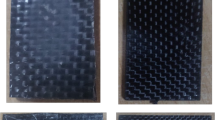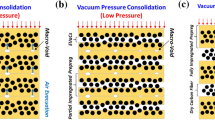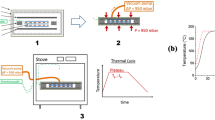Abstract
In this study, vacuum-assisted material extrusion (~ 1 Pa) is performed to eliminate matrix voids and improve the bonding quality of deposited layers by reducing heat loss and entrapped air during manufacturing. Continuous flax fibers with short polyester fibers/polylactic acid matrix sandwich composites (skin/core thicknesses of 2 and 25.4 mm, respectively) are fabricated via vacuum-assisted material extrusion. Compared with material extrusion, vacuum-assisted material extrusion yields higher bending and short-beam shear strengths by 36.6% and 27.2%, respectively; higher bending and short-beam shear stiffnesses by 12.3% and 9.5%, respectively; and higher averaged loading cycles at the failure stage by 47.3% and 101.5% in the three-point bending and short-beam shear loads, respectively. Vacuum-assisted material extrusion with surface coating is convenient, low cost, high in dimensional accuracy, and does not require reduced printing speed compared with conventional methods, thus satisfying the industrial targets of carbon emission reduction and high-volume production cleaning.








Similar content being viewed by others
Data availability
The data that support the findings of this study are available from the corresponding author upon reasonable request.
References
Cao D, Malakooti S, Kulkarni VN, Ren Y, Liu Y, Nie X, Qian D, Todd Griffith D, Lu H (2021) The effect of resin uptake on the flexural properties of compression molded sandwich composites. Wind Energy. https://doi.org/10.1002/we.2661. (Published online 2021)
Cao D, Malakooti S, Kulkarni VN, Ren Y, Lu H (2020) Nanoindentation measurement of core–skin interphase viscoelastic properties in a sandwich glass composite. Mech Time Depend Mater. https://doi.org/10.1007/s11043-020-09448-y. (Published online)
Birman V, Kardomateas GA (2018) Review of current trends in research and applications of sandwich structures. Compos B Eng 142:221–240. https://doi.org/10.1016/J.COMPOSITESB.2018.01.027
Wang X, Xu T, de Andrade MJ et al (2021) The interfacial shear strength of carbon nanotube sheet modified carbon fiber composites. In: Challenges in mechanics of time-dependent materials, vol 2. Conference proceedings of the society for experimental mechanics series. https://doi.org/10.1007/978-3-030-59542-5_4
Kamarian S, Song JI (2022) Review of literature on eco-friendly sandwich structures made of non-wood cellulose fibers. J Sandw Struct Mater 24(3):1653–1705. https://doi.org/10.1177/10996362211062372
Naqvi SR, Prabhakara HM, Bramer EA, Dierkes W, Akkerman R, Brem G (2018) A critical review on recycling of end-of-life carbon fibre/glass fibre reinforced composites waste using pyrolysis towards a circular economy. Resour Conserv Recycl 136:118–129. https://doi.org/10.1016/J.RESCONREC.2018.04.013
Moudood A, Rahman A, Khanlou HM, Hall W, Öchsner A, Francucci G (2019) Environmental effects on the durability and the mechanical performance of flax fiber/bio-epoxy composites. Compos B Eng 171:284–293. https://doi.org/10.1016/J.COMPOSITESB.2019.05.032
Wang X, Petrů M, Xia L (2021) Modeling the dynamics behavior of flax fiber reinforced composite after water aging using a modified Huet-Sayegh viscoelastic model with fractional derivatives. Constr Build Mater 290:122879. https://doi.org/10.1016/J.CONBUILDMAT.2021.122879
Zhang L, Li Z, Pan YT et al (2018) Polydopamine induced natural fiber surface functionalization: a way towards flame retardancy of flax/poly(lactic acid) biocomposites. Compos B Eng 154:56–63. https://doi.org/10.1016/J.COMPOSITESB.2018.07.037
Kumar R, Yakubu M, Anandjiwala R (2010) Biodegradation of flax fiber reinforced poly lactic acid. Express Polym Lett 4(7):423–430. https://doi.org/10.3144/expresspolymlett.2010.53
Rostami R, Zarrebini M, Mandegari M, Mostofinejad D, Abtahi SM (2020) A review on performance of polyester fibers in alkaline and cementitious composites environments. Constr Build Mater 241:117998. https://doi.org/10.1016/J.CONBUILDMAT.2020.117998
Yiga VA, Lubwama M, Pagel S, Benz J, Olupot PW, Bonten C (2021) Flame retardancy and thermal stability of agricultural residue fiber-reinforced polylactic acid: a review. Polym Compos 42(1):15–44. https://doi.org/10.1002/PC.25835
Moon RJ, Martini A, Nairn J, Simonsen J, Youngblood J (2011) Cellulose nanomaterials review: structure, properties and nanocomposites. Chem Soc Rev 40(7):3941–3994. https://doi.org/10.1039/c0cs00108b
Farah S, Anderson DG, Langer R (2016) Physical and mechanical properties of PLA, and their functions in widespread applications—a comprehensive review. Adv Drug Deliv Rev 107:367–392. https://doi.org/10.1016/J.ADDR.2016.06.012
Chapple S, Anandjiwala R (2010) Flammability of natural fiber-reinforced composites and strategies for fire retardancy: a review. J Thermoplast Compos Mater 23(6):871–893. https://doi.org/10.1177/0892705709356338
van de Werken N, Tekinalp H, Khanbolouki P, Ozcan S, Williams A, Tehrani M (2019) Additively manufactured carbon fiber-reinforced composites: state of the art and perspective. Addit Manuf. https://doi.org/10.1016/j.addma.2019.100962. (Published online)
Yu T, Zhang Z, Song S, Bai Y, Wu D (2019) Tensile and flexural behaviors of additively manufactured continuous carbon fiber-reinforced polymer composites. Compos Struct 225(June):111147. https://doi.org/10.1016/j.compstruct.2019.111147
Xu J, Wu Y, Wang L et al (2018) Compressive properties of hollow lattice truss reinforced honeycombs (Honeytubes) by additive manufacturing: Patterning and tube alignment effects. Mater Des 156:446–457. https://doi.org/10.1016/J.MATDES.2018.07.019
Zadi-Maad A, Rohib R, Irawan A (2018) Additive manufacturing for steels: a review. IOP Conf Ser Mater Sci Eng 285:012028. https://doi.org/10.1088/1757-899X/285/1/012028
Mitchell A, Lafont U, Hołyńska M, Semprimoschnig C (2018) Additive manufacturing—a review of 4D printing and future applications. Addit Manuf 24:606–626. https://doi.org/10.1016/J.ADDMA.2018.10.038
Li L, Tirado A, Nlebedim IC et al (2016) Big area additive manufacturing of high performance bonded NdFeB magnets. Sci Rep 6(1):1–7. https://doi.org/10.1038/srep36212
Duty CE, Kunc V, Compton B et al (2017) Structure and mechanical behavior of big area additive manufacturing (BAAM) materials. Rapid Prototyp J 23(1):181–189. https://doi.org/10.1108/RPJ-12-2015-0183/FULL/PDF
Bekas DG, Hou Y, Liu Y, Panesar A (2019) 3D printing to enable multifunctionality in polymer-based composites: a review. Compos B Eng 179:107540. https://doi.org/10.1016/j.compositesb.2019.107540
Narayana J, Gupta Burela R (2018) A review of recent research on multifunctional composite materials and structures with their applications. Mater Today Proc 5:5580–5590
Alexandre A, Cruz Anchez FA, Boudaoud H, Camargo M, Pearce JM (2020) Mechanical properties of direct waste printing of polylactic acid with universal pellets extruder: comparison to fused filament fabrication on open-source desktop three-dimensional printers. 3D Print Addit Manuf 7(5):237–247. https://doi.org/10.1089/3DP.2019.0195
Fidan I, Imeri A, Gupta A et al (2019) The trends and challenges of fiber reinforced additive manufacturing. Int J Adv Manuf Technol 102(5–8):1801–1818. https://doi.org/10.1007/S00170-018-03269-7/METRICS
Bharath HS, Bonthu D, Gururaja S, Prabhakar P, Doddamani M (2021) Flexural response of 3D printed sandwich composite. Compos Struct 263:113732. https://doi.org/10.1016/J.COMPSTRUCT.2021.113732
Zhang X, Fan W, Liu T (2020) Fused deposition modeling 3D printing of polyamide-based composites and its applications. Compos Commun 21:100413. https://doi.org/10.1016/J.COCO.2020.100413
Webbe Kerekes T, Lim H, Joe WY, Yun GJ (2019) Characterization of process–deformation/damage property relationship of fused deposition modeling (FDM) 3D-printed specimens. Addit Manuf 25:532–544. https://doi.org/10.1016/J.ADDMA.2018.11.008
Maidin S, Mohamed AS, Akmal S, Mohamed SB, Wong JHU (2018) Feasibility study of vacuum technology integrated fused deposition modeling to reduce staircase effect. J Fundam Appl Sci 10(1S):633–645. https://doi.org/10.4314/jfas.v10i1S
Maidin S, Wong JHU, Mohamed AS, Mohamed SB, Rashid RA, Rizman ZI (2018) Vacuum fused deposition modelling system to improve tensile strength of 3D printed parts. J Fundam Appl Sci 9(6S):839–853. https://doi.org/10.4314/jfas.v9i6S.63
Hu F, An L, Chivate AT et al (2020) Flexible and printable dielectric polymer composite with tunable permittivity and thermal stability. Chem Commun 56(15):2332–2335. https://doi.org/10.1039/c9cc08648j
Parlevliet PP, Bersee HEN, Beukers A (2007) Residual stresses in thermoplastic composites—a study of the literature. Part III: effects of thermal residual stresses. Compos Part A Appl Sci Manuf 38(6):1581–1596. https://doi.org/10.1016/j.compositesa.2006.12.005
Mohamed AS, Mohamed SB (2023) Effect of vacuum assisted fused deposition modeling on 3D Printed ABS microstructure. Int J Appl Eng Res. http://www.ripublication.com Accessed 16 Feb (Published online 2017)
ASTM International (2016) Standard test method for measuring abrasion using the dry sand/rubber wheel apparatus. ASTM International, West Conshohocken. https://doi.org/10.1520/G0065-16E01
ASTM International. ASTM C297 standard test method for flatwise tensile strength of sandwich constructions. ASTM International, ASTM International
ASTM D2344/D2344M—16 standard test method for short-beam strength of polymer matrix composite materials and their laminates. https://www.astm.org/Standards/D2344.htm. Accessed 6 Nov 2021
ASTM International. ASTM D790—17 standard test methods for flexural properties of unreinforced and reinforced plastics and electrical insulating materials. https://www.astm.org/Standards/D790. Accessed 4 May 2021 (Published 2017.)
Jesthi DK, Nayak RK (2019) Improvement of mechanical properties of hybrid composites through interply rearrangement of glass and carbon woven fabrics for marine application. Compos B Eng 168:467–475. https://doi.org/10.1016/J.COMPOSITESB.2019.03.042
Jin FL, Hu RR, Park SJ (2019) Improvement of thermal behaviors of biodegradable poly(lactic acid) polymer: a review. Compos B Eng 164:287–296. https://doi.org/10.1016/J.COMPOSITESB.2018.10.078
Wang B, Yang B, Wang M, Zheng Y, Hong X, Zhang F (2019) Effect of cutting temperature on bending properties of carbon fibre reinforced plastics. IEEE J Sel Top Quantum Electron 26(1):394–401. https://doi.org/10.1515/SECM-2019-0019/MACHINEREADABLECITATION/RIS
Zavatta N, Rondina F, Falaschetti MP, Donati L (2021) Effect of thermal ageing on the mechanical strength of carbon fibre reinforced epoxy composites. Polymers (Basel) 13(12):2006. https://doi.org/10.3390/POLYM13122006
Tefera G, Adali S, Bright G (2022) Mechanical behavior of GFRP laminates exposed to thermal and moist environmental conditions: experimental and model assessment. Polymers (Basel) 14(8):1523. https://doi.org/10.3390/POLYM14081523
Sawpan MA, Holdsworth PG, Renshaw P (2012) Glass transitions of hygrothermal aged pultruded glass fibre reinforced polymer rebar by dynamic mechanical thermal analysis. Mater Des 42:272–278. https://doi.org/10.1016/J.MATDES.2012.06.008
Al-Tameemi HA, Ali AAH, Hussein B (2020) Investigation of wear resistance for variable configurations of woven glass-fiber reinforced composite materials. Mater Res Express 7(9):095303. https://doi.org/10.1088/2053-1591/abb2cf
Acknowledgements
The author would like to thank the Department of Mechanical and Automotive Engineering at Hefei University of Technology for providing the materials and the material extrusion manufacturing platform.
Author information
Authors and Affiliations
Corresponding author
Ethics declarations
Conflict of interest
The authors declare that they have no competing financial interests or personal relationships that could have influenced the work reported herein.
Additional information
Publisher's Note
Springer Nature remains neutral with regard to jurisdictional claims in published maps and institutional affiliations.
Rights and permissions
Springer Nature or its licensor (e.g. a society or other partner) holds exclusive rights to this article under a publishing agreement with the author(s) or other rightsholder(s); author self-archiving of the accepted manuscript version of this article is solely governed by the terms of such publishing agreement and applicable law.
About this article
Cite this article
Cao, D. Investigation into surface-coated continuous flax fiber-reinforced natural sandwich composites via vacuum-assisted material extrusion. Prog Addit Manuf (2023). https://doi.org/10.1007/s40964-023-00508-6
Received:
Accepted:
Published:
DOI: https://doi.org/10.1007/s40964-023-00508-6




